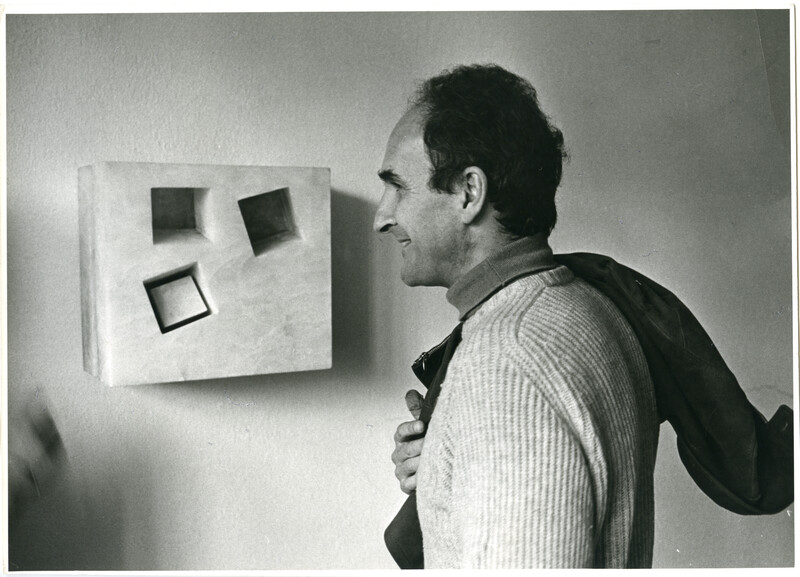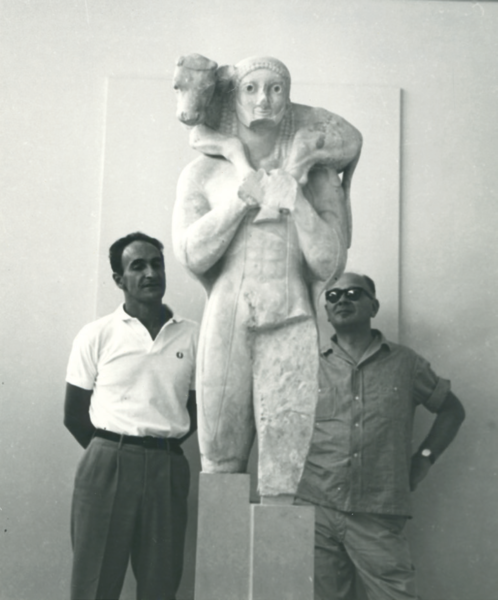Essays
Eduardo Chillida: Searching for Light

Eduardo Chillida with ‘Homage to Kandinsky’. Courtesy of Estate of Eduardo Chillida and Hauser & Wirth © Zabalaga Leku. San Sebastian, VEGAP, 2019. Photo: Walter Dräye
Set in the landscape of the Basque Country, Chillida Leku is a unique museum created by Spanish sculptor Eduardo Chillida in his lifetime. Nature and art, the interior space of the country house and the large outdoor sculptures are in harmonious dialogue. For the current exhibition at the museum, ‘Searching for Light. Eduardo Chillida’, we delve into the roots and poetic power of one of the artist’s first works in alabaster, ‘Homage to Kandinsky’.
Inspiration
In 1963, Chillida travelled to Greece with his wife Pilar Belzunce and the poet Jacques Dupin. It was here he experienced expansive white buildings, which allowed a plethora of Mediterranean light to pass through the empty space of architectural interiors. He spent time on the Cyclades Islands, whose unique views and visibility have inspired the poetry of Rilke and architect Louis Khan, whom Chillida greatly admired. During this trip, the trio went from Greece to Rome, where Chillida encountered post-Impressionist sculptures by Medardo Rosso, for whom ‘light is the very essence of our existence’. Upon returning home, he endeavoured to develop his unique sculptural lexicon by combining the inspiration he found during this holiday with the spirit of his homeland, the Basque country. Whilst Chillida had originally studied architecture from 1943-47, works made after these encounters were reinvigorated with the spatial possibilities of the discipline.

Chillida with Louis Clayeux in Greece, 1963. Courtesy of Estate of Eduardo Chillida and Hauser & Wirth © Zabalaga Leku. San Sebastian, VEGAP, 2019. Photo: Walter Dray

Eduardo Chillida, Estudio Homenage a Kandinski (Study Homage to Kandinski), 1965 © Zabalaga Leku. San Sebastian, VEGAP, 2019. Photo: Alex Abril
‘...this stone would seem defaced beneath the translucent cascade of the shoulders’ —Rilke
Material
In the early 1960s, Chillida’s use of material was proliferating, expanding from work with iron to granite, alabaster and wood. ‘Homage to Kandinsky’ was the artist’s first work created using alabaster and was made through a process of hollowing out and perforating a solid block. His simple, repeated orthogonal cuts skilfully highlight the marbled translucency of the material. Alabaster opened up new possibilities for working with light, as opposed to the malleability and darker colors of iron. In Rilke’s poem ‘Archaic Torso of Apollo’, the antithesis of dark and light, iron and alabaster, are suffused in parallel to Chillida’s use of material: ‘that dark center where procreation flared / Otherwise this stone would seem defaced / beneath the translucent cascade of the shoulders’. It is this poetic and deeply spiritual sense of light in sculpture that Chillida imbued his material with. The artist made many other works in alabaster, including the 14-part series ‘Elogios de la luz (In Praise of Light)’, ‘Elogios de la arquitectura (In Praise of Architecture)’ and ‘Arquitecturas heterodoxas (Unorthodox Architecture)’.

Eduardo Chillida, Elogio de la Luz XX (In Praise of the Light XX), 1990 © Zabalaga Leku. San Sebastian, VEGAP, 2019. Photo: Eduardo Chillida Archive

Installation view, Echoes, Chillida Leku, Hernani, Spain, 2019 © Zabalaga Leku. San Sebastian, VEGAP, 2019. Photo: Gonzalo Machado
Space
Naming himself an ‘architect of the void’, Chillida’s focus on negative space permeates through both the spirit of his works and the physical making process. It was this metaphysical enquiry into interior, blank space that forges the unique character of Chillida’s forms and lead the philosopher Gaston Bachelard to characterise his practice as ‘drawing attention above all to interior space’. For Bachelard, Chillida’s use of iron forms ‘a metallic cosmos, [where] one not only has to contemplate, one has to participate in the burning flux of a creative violence’.
Whilst alabaster signalled the artist’s move away from iron during this period, it might also be suggested that the cosmic quality of interior space, the ‘void’, takes on new significance in works such as ‘Homage to Kandinsky’, where the inner space of the work is partially obscured from the position of the viewer. At the same time, the luminosity and incisions in Chillida’s alabaster works mean they reveal to us a unique profundity, and thus the work suggests the visible and invisible. The sculptures invite a myriad of interpretations, allowing viewers to adjust their perspective and ambulate around plinths or through slants of light in his Zabalaga country house.
‘Homage to Kandinsky’, a selection of alabaster works and iron sculptures are included in ‘Eduardo Chillida. Searching for Light’, on view at Chillida Leku in the Basque Country from 6 December 2019 – 1 June 2020.
